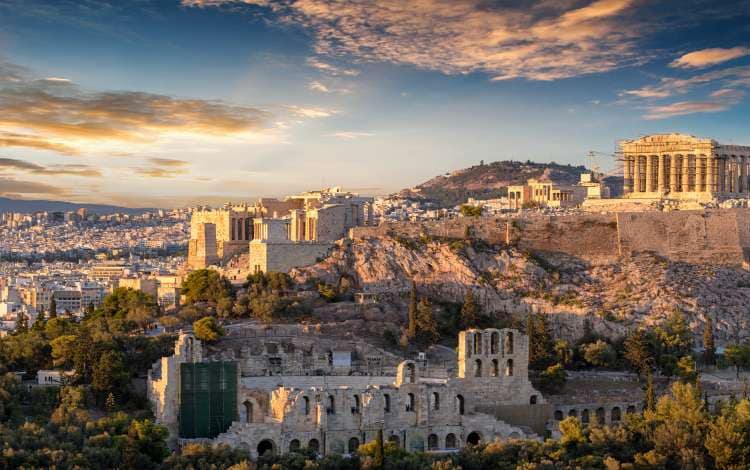Top things to do in Valletta
Explore more on the Mediterranean



I love Corfu because it combines tranquility with vibrancy. The island is buzzing with people and ideas, and there is a settled artist community that provides me with great inspiration and feedback. It’s a place where I can perform my music, exhibit my art and be appreciated – isn’t this what a true artist craves?
I can wake up, take my drawing book and violin, sit on the beach and compose, undisturbed. After a concert, I can just dip in the sea and take a swim. Paleokastritsa is my favourite spot: it’s a fantastic beach with crystal-clear water surrounded by spectacular rock formations.
Come in the summer and you’re likely to bump into one of Corfu’s marching bands. We have 18 of them and they’re quite a spectacle – children and adults marching together through the narrow, cobbled streets of Corfu Old Town. This, and much more, is the spirit of Corfu.

The Mediterranean culture appeals to me, so when I hit 60 I decided it was time to retire and rethink. By then I had discovered Heraklion, a very underrated destination.
I knew what to expect: hospitable people, wonderful food, constant sun and a mild climate. But the city is also like a mini Athens: cultural, cosmopolitan with a delightful old centre. There are almost daily events in the summer – some free, some ticketed – in the magnificent open-air theatres.
Take a stroll by the Venetian walls in the Old Town and climb up to the well-tended grave of Nikos Kazantzakis, author of Zorba the Greek, for the best city view. A 10-minute bus ride away is Ammoudara, a mile-long sandy beach. Have a swim there and afterwards lie on a free lounger drinking frappé (iced coffee). And definitely go to Knossos; there are many archaeological sites, but this tops them all for organisation. Finally, don’t miss out on the local specialities such as stifado (meat and onion stew), stuffed peppers, or dakos (rusks with tomatoes and olive oil), complete with a glass of tsikoudia, the local fire water, which is always offered free at the end of your meal.

How can I describe Mykonos? This is an island blessed by the gods. Every corner hides a beach. Mersini is my favourite but there are so many.
The island is barren and there’s no cover from the sun, so it radiates freedom. Mykonos taught me to be free. As a designer, I like simple curves and shapes of Mykonos. The traditional architecture here is simple and sensual. This Cycladic simplicity is reflected in my work. But there is movement, too, matching the island’s dynamic, the freedom of its bohemianism, its beauty, its light.
I like to take the boat to the island of Delos. It’s a fantastic UNESCO protected place – don’t miss it. Visit the Ano Mera monastery, too. It gets few visitors and is a surprise: Baroque, not Greek Orthodox.
In Mykonos archaeological museum you’ll find a vase with a relief of the Trojan war. The shape is effortless, and the lines are continuous and minimal. I feel an affinity with that ancient artist. We’ve both been influenced by the island in the same way.

Rhodes is one of a kind: amazing beaches, medieval castles and archaeological sites. Its beauties are endless. Take Lindos, an iconic place defining the Aegean ideal: white houses, narrow streets with donkeys for transport up the steep slope to the Acropolis of Lindos and a mix of azure sky and turquoise sea. Tsambika is an amazing beach with golden sands and clear, shallow waters, overlooked by a monastery at one end and a promontory on the other – it’s perfect for families.
Medieval Rhodes town is fascinating. There is Italian architecture, a mixture of Art Deco with unusual motifs of sea animals. The Italians were conquerors, but they also restored our medieval castle originally built by the Knights of Saint John. The restoration is not to everyone’s taste, but what would have happened without it? We’d have another set of glorious ruins.
Rhodes is a stony island and through my work I’m trying to take one step forward supporting the Greek building tradition. We’re here to improve what we have inherited, add to our knowledge and pass it on to the next generation.

Santorini promises fantastic sights, and it certainly delivers. Arriving by boat – sailing inside a still-active volcanic crater and unforgettable moments you are likely to experience.
If you’re a photographer, the sunsets around the caldera are bewitching. If you like history, go to Akrotiri to marvel at a 3,500-year-old city. If you like lazing in the sun, we have beaches with black, white and red sand; my favourite one is Perivolos, its chick-pea-sized black gravel stretching for 5km. If you’re a foodie try our flavourful tomatinia (pygmy tomatoes), our signature white aubergines and fava (chick-pea purée). But most of all, try our wine.
My family has been making wine for four generations and, in terms of quality and reputation, Santorini is the leader among Greece’s wine regions. Assyrtiko reigns dominant among the nine indigenous varieties. It’s been cultivated on the island for centuries without foreign injections; its vines grow horizontally in entwined wreaths for protection against the strong Aegean winds.
of
Don’t miss out! Sign up for latest news, offers and competitions from P&O Cruises.